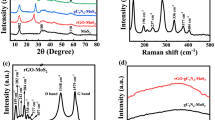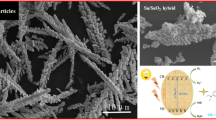Abstract
Graphite phase carbon nitride (g-C3N4) is a non-metal semiconductor material with a suitable band gap (2.7 eV) for visible photocatalysis. However, the high cost of relevant synthesis methods and poor adsorption performance have limited its practical applications. The objective of the present study was to mitigate these problems by synthesizing the g-C3N4 in the presence of exfoliated montmorillonite (Mnt). Compared with bulk montmorillonite, the specific surface area of exfoliated two-dimensional Mnt layers was significantly increased. As a result, the light transmittance of the lamella improved noticeably due to the fact that a freshly exposed surface had a large number of active reaction sites, making Mnt an excellent carrier for the photocatalyst g-C3N4. In order to improve the photocatalytic performance of g-C3N4, a series of g-C3N4/Mnt composites was prepared by a wet chemical method using Mnt nanolayers as the matrix. X-ray diffraction, infrared spectroscopy, Brunauer-Emmett-Teller nitrogen adsorption/desorption, transmission electron microscopy, and ultraviolet-visible diffuse reflectance spectroscopy were used to analyze the phase structure, the chemical bonds, the specific surface area and pore sizes, the morphology, and the light absorption characteristics of the composites, respectively. Rhodamine B (RhB) served as the target dye to test the photocatalytic degradation performance of the composites under visible light. According to the findings, the surface of the Mnt nanolayers was densely and uniformly covered by g-C3N4, forming a multi-layered stack structure. An increase of the calcination temperature improved the crystallinity of g-C3N4, leading first to densification and then to relaxation of the layered composite structure. Conversely, the band gap of the composite gradually decreased from 2.56 to 2.4 eV. Furthermore, temperature exposure changed the photocatalytic performance of the composite drastically. While the largest photocatalytic activity was observed at 610°C, it started to decrease with further heating of the composite. The complete degradation of RhB solution occurred after 2 h of visible light irradiation. The findings of the current study provide a scientific basis for the synthesis of a new generation of photocatalysts.








Similar content being viewed by others
References
Al-Ghouti, M. A., Khraisheh, M., Ahmad, M., & Allen, S. (2009). Adsorption behaviour of methylene blue onto Jordanian diatomite: a kinetic study. Journal of Hazardous Materials, 165(1-3), 589–598.
Chang, F., **e, Y., Li, C., Chen, J., Luo, J., Hu, X., et al. (2013). A facile modification of g-C3N4 with enhanced photocatalytic activity for degradation of methylene blue. Applied Surface Science, 280, 967–974.
Cheng, W., Shi, H., Pu, Z., & Yan, L. (2011). Synthesis and characterization of kaolinite/TiO2 nano-photocatalysts. Applied Clay Science, 53, 646–649.
Davis, E. A., & Mott, N. F. (1970). Electrical and Transparent Properties of Amorphous Semiconductor. Philosophical Magazine, 22, 903–920.
Dong, G., Zhang, Y., Pan, Q., & Qiu, J. (2014). A fantastic graphitic carbon nitride (g-C3N4) material: Electronic structure, photocatalytic and photoelectronic properties. Journal of Photochemistry and Photobiology C: Photochemistry Reviews, 20, 33–50.
Fatimah, I., Wang, S., & Wulandari, D. (2011). ZnO/montmorillonite for photocatalytic and photochemical degradation of methylene blue. Applied Clay Science, 53, 553–560.
Fujishima, A., Zhang, X., & Tryk, D. (2008). TiO2 photocatalysis and related surface phenomena. Surface Science Reports, 63, 515–582.
Herron, J. A., Kim, J., Upadhye, A. A., Huber, G. W., & Maravelias, C. T. (2015). A general framework for the assessment of solar fuel technologies. Energy & Environmental Science, 8, 126–157.
Huang, J., & Li, Z. (2012). X-ray diffraction of polycrystalline materials: experimental principle, method and application [M]. Metallurgical Industry Press.
Kumar, S., Karthikeyan, S., & Lee, A. (2018). g-C3N4-Based Nanomaterials for Visible Light-Driven Photocatalysis. Catalysts, 8(74), 1–47.
Li, C., Sun, Z., Huang, W., & Zheng, S. (2016). Facile synthesis of g-C3N4/montmorillonite composite with enhanced visible light photodegradation of rhodamine B and tetracycline. Journal of the Taiwan Institute of Chemical Engineers, 66, 363–371.
Li, C., Sun, Z., Zhang, W., Yu, C., & Zheng, S. (2018). Highly efficient g-C N /TiO /kaolinite composite with novel threedimensional structure and enhanced visible light responding ability towards ciprofloxacin and s. aureus. Applied Catalysis B Environmental, 220, 272–282.
Li, J., Liu, E., Ma, Y., Hu, X., Wan, J., Sun, L., & Fan, L. (2016). Synthesis of MoS2/g-C3N4 nanosheets as 2D heterojunction photocatalysts with enhanced visible light activity. Applied Surface Science, 364(28), 694–702.
Li, P. P., Huang, L.Y., Li, Y.P., Xu, Y.G., Huang, S.Q., Yuan, D., Xu, H., & Li, H.M. (2017). Synthesis of dark orange montmorillonite/g-C N composites and their applications in the environment. Journal of Physics & Chemistry of Solids, 107, 131–139.
Li, S., Kun, C., Huabin, Z., **ao, H., Liuqing, Y., Tao, W., & **hua, Y. (2016). Drastic Enhancement of Photocatalytic Activities over Phosphoric Acid Protonated Porous g-C3N4 Nanosheets under Visible Light. Small, 12(32), 4431–4439.
Li, Y., Zhan, J., Huang, L., Xu, H., Li, H., Zhang, R., & Wu, S. (2014). Synthesis and photocatalytic activity of a bentonite/g-C N composite. RSC Advances, 4(23), 11831–11839.
Liang, Q. (2015). Holey Graphitic Carbon Nitride Nanosheets with Carbon Vacancies for Highly Improved Photocatalytic Hydrogen Production. Advanced Functional Materials, 25(44), 6885–6892.
Liu, L., Shi, Y., Yu, B., Tai, Q., Wang, B., Feng, X., Liu, H., Wen, P., Yuan, B., & Hu, Y. (2015). Preparation of layered graphitic carbon nitride/montmorillonite nanohybrids for improving thermal stability of sodium alginate nanocomposites. RSC Advances, 5(16), 11761–11765.
Peng, K., Fu, L., Ouyang, J., & Yang, H. (2016). Emerging Parallel Dual 2D Composites: Natural Clay Mineral Hybridizing MoS2 and Interfacial Structure. Advanced Functional Materials, 26(16), 2666–2675.
Ralph, E. G., Richards, A. R. (1942). Differential thermal analysis of clay minerals and other hydrous materials. part 1. American Mineralogist, 27(11), 746–761.
Shi, Y.Q., Jiang, S.H., Zhou, K.Q., Wang, B.B., Gui, G., Hu, Y., & Yuen, K.K. (2013). Facile preparation of ZnS / g-C3N4 nanohybrids for enhanced optical properties. RSC Advances, 4(6), 2609–2613.
Shi, L., Chang, K., Zhang, H., Hai, X., Yang, L., Wang, T., & Ye, J.H. (2016). Drastic Enhancement of Photocatalytic Activities over Phosphoric Acid Protonated Porous g-C N Nanosheets under Visible Light. Small, 12(32), 4431–4439.
Shmuel, Y., Müller-Vonmoos, M., Gunter, K., & Anton, R. (1989). Thermal analytic study of the adsorption of crystal violet by montmorillonite. Thermochimica Acta, 148(6), 457–466.
Sonawane, S.H., Gumfekar, S.P., Kate, K.H., Meshram, S.P., Kunte, K.J., Ramjee, L., Mahajan C.M., Parande M.G., & Ashokkumar M. (2010). Hydrodynamic cavitation-assisted synthesis of nanocalcite. International Journal of Chemical Engineering, 2010, 1–8.
Sun, Z., Chen, Y., Qiang, K., Ye, Y., & Yuan, J. (2002). Photocatalytic degradation of a cationic azo dye by TiO2/bentonite nanocomposite. Journal of Photochemistry and Photobiology, A: Chemistry, 149, 169–174.
Swinehart, D.F. (1962). The Beer-Lambert Law. Journal of Chemical Education, 39(7), 333–335.
Tauc, J. (1974). Optical Properties of Amorphous Semiconductors. Amorphous and Liquid Semiconductors., 4, 159–220.
Thomas, A., Fischer, A., Frederic, Goettmann, F., Antonietti, M., Muller, J.O., Schlogl, R., & Carlsson, J.M. (2008). Graphitic carbon nitride materials: variation of structure and morphology and their use as metal-free catalysts. Journal of Materials Chemistry, 18(41), 4893–4908.
Wang, X.C., Maeda, K., Thomas, A., Takanabe, K., **n, G., Carlsson, J.M., Domen, K., & Antonietti, M. (2009). A metal-free polymeric photocatalyst for hydrogen production from water under visible light. Nature Material, 8, 76–80.
Wang Y.Y., Zhao, S., Zhang, Y.W., Chen, W.X., Yuan, S.H., Zhou, Y.M., & Huang, Z.W. (2018). Synthesis of graphitic carbon nitride with large specific surface area via copolymerizing with nucleobases for photocatalytic hydrogen generation. Applied Surface Science, 463, 1–8.
Xue, J., Ma, S., Zhou, Y., Zhang, Z., & He, M. (2015). Facile photochemical synthesis of Au/Pt/g-C3N4 with plasmon-enhanced photocatalytic activity for antibiotic degradation. ACS Applied Materials & Interfaces, 7, 9630–9637.
Yan, S. C., Li, Z. S., & Zou, Z. G. (2009). Photodegradation performance of g-C3N4 fabricated by directly heating melamine. Langmuir, 25, 10397–10401.
Zhao, W., & Tan, W. F. (2018). Quantitative and structural analysis of minerals in soil clay fractions developed under different climate zones in China by XRD with Rietveld method, and its implications for pedogenesis. Applied Clay Science, 162, 351–361.
Acknowledgments
This work was supported by the National Natural Science Foundation of China (Grant No. 42072048, 41772036).
Funding
Funding sources are as stated in the Acknowledgments.
Author information
Authors and Affiliations
Corresponding author
Ethics declarations
Conflict of interest
The authors declare that they have no conflict of interest.
Additional information
Associate Editor: Yael Mishael
Rights and permissions
Springer Nature or its licensor holds exclusive rights to this article under a publishing agreement with the author(s) or other rightsholder(s); author self-archiving of the accepted manuscript version of this article is solely governed by the terms of such publishing agreement and applicable law.
About this article
Cite this article
Li, Y., Sun, H., Peng, T. et al. Effect of temperature on the synthesis of g-C3N4/montmorillonite and its visible-light photocatalytic properties. Clays Clay Miner. 70, 555–565 (2022). https://doi.org/10.1007/s42860-022-00201-9
Accepted:
Published:
Issue Date:
DOI: https://doi.org/10.1007/s42860-022-00201-9




